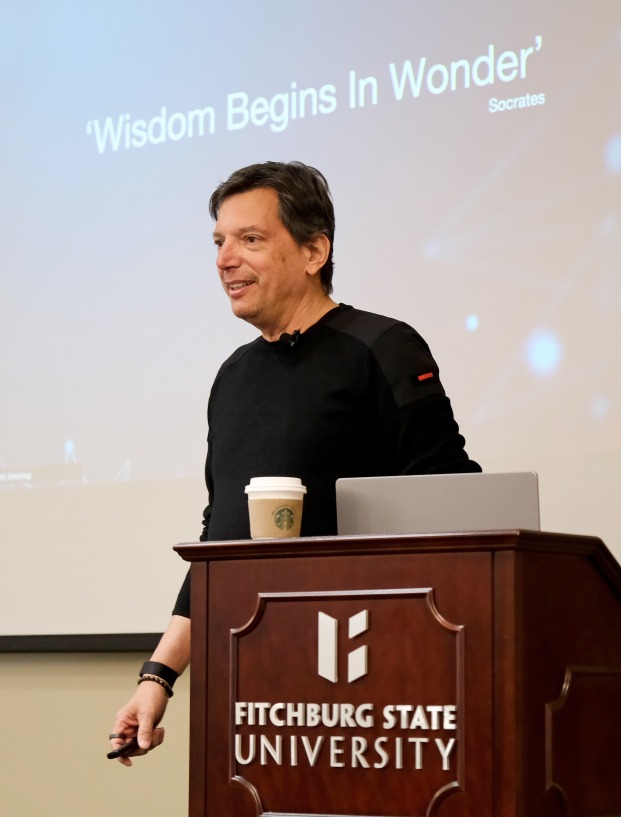Richard Kerris ‘83 returned to campus this spring to recount his journey from Fitchburg State to the frontiers of technology, and the importance of asking questions and being resilient in the face of challenges. Now Vice President of Developer Relations at NVIDIA, Kerris counts Apple and Lucasfilm among his prior career stops, where he has been on the front line of the technology revolution.
He got his start studying video production at Fitchburg State in the early years of the Communications Media Department. More interested in music than news, Kerris recalled not wanting to do an internship with one of the Boston TV stations. Professor Gunther Hoos encouraged him to follow his interests, and Kerris ended up creating music videos at Boston venues like Spit and Metro.
One act he wanted to film was pioneering recording artist and producer Todd Rundgren. Not knowing how to reach him, he called directory assistance and, to his surprise, got a phone number. Rundgren gave his OK to the filming, and a lifelong friendship began. That video internship turned into a business that included working on over 200 videos for many other artists who came through Boston during those next few years.
“Being able to ask the question is what made those opportunities come to light,” Kerris said.
While he enjoyed creating music videos, Kerris needed the stability of a day job. He made his way to Cubicomp, which manufactured a graphics system called PictureMaker. “I started to learn how to use this, and I started to learn how to sell it,” he said.
That job took him to a computer graphics conference in 1985. “When I went there, it was more than Disneyland,” he said. “It was seeing the latest and greatest of what was taking place in computer graphics. These were the real stars in my new world.”
Among those stars was graphics pioneer Ed Catmull and other visionaries who had co-founded Pixar, which at that time was making physical computer systems. “I stayed in their booth and I asked, ‘How can I work here?’”
A few months later, he was there. Pixar was creating new systems and testing software down the hall with a small unit that produced cutting edge computer animation. That work resulted in the company shifting gears to becoming an animation studio. “Everything changed overnight,” Kerris said.
Kerris moved on to Silicon Graphics, where its next-generation computers were the size of refrigerators and ran on high-end 3D software that was being used by George Lucas’ visual effects company Industrial Light and Magic. Kerris was there when the company produced the landmark effects for “Jurassic Park,” creating another seismic shift in the industry.
Recruited to the tech company Wavefront and its more desirable headquarters in Santa Barbara, Kerris spent 18 months working with the team who was building on a new computer graphics application called Maya that was later ported to Apple’s new Mac OS X (UNIX) operating system. During his time with Apple, Kerris shared the stage with Steve Jobs at several of the legendary founder’s famed keynote addresses, and worked with the Rolling Stones to help launch the iTunes platform (and later collaborated with them on using emerging miniature camera technology to create a more dazzling content for their mobile app for their 50th anniversary tour).
The threads that you make and the connections you make will stay with you through your entire career.
Kerris said he was surprised when he found himself being recruited by Lucasfilm to serve as its chief technology officer, despite his lack of training as an engineer. But his knowledge and experience using software and building ecosystems was put to good use as company founder George Lucas sought to create tools that would help future generations of filmmakers.
“It taught me a lot about myself, how teams work, and what can and can’t be a product for day to day use,” Kerris said. Graphics processing units created during his time at Lucasfilm continue to be used in visual effects and other operating systems.
Following his time at Lucasfilm and a brief tenure at HP where he worked on web-based portable devices, Kerris was recruited to join the team at NVIDIA by an old friend, and he remains there now. “The threads that you make and the connections you make will stay with you through your entire career,” he said.
Kerris has seen the disruptive power of technology, and sees the approach of generative AI (artificial intelligence) and its potential applications as a positive and not something to be feared.
“Generative AI is going to allow us to be in control of the computer,” Kerris said. “Historically, computers have made us their slaves. You got the computer, you had to learn the software. Going forward, it’s the reverse. You’ll be able to tell the computer, ‘I want a software product that does this, or an application that does that.’ In the same way we’ve overcome and taken control of other technologies throughout time, so will we in this harnessing of AI and what it can do for us. The future is unwritten. You’re going to do it by embracing it and making it your own, not by shying away from it and saying, ‘I’d rather stick with my horse.’ No, get in the car and drive.”

